International Journal of Applied Engineering Research
VerifiedAdded on 2022/08/26
|7
|1914
|19
AI Summary
Contribute Materials
Your contribution can guide someone’s learning journey. Share your
documents today.
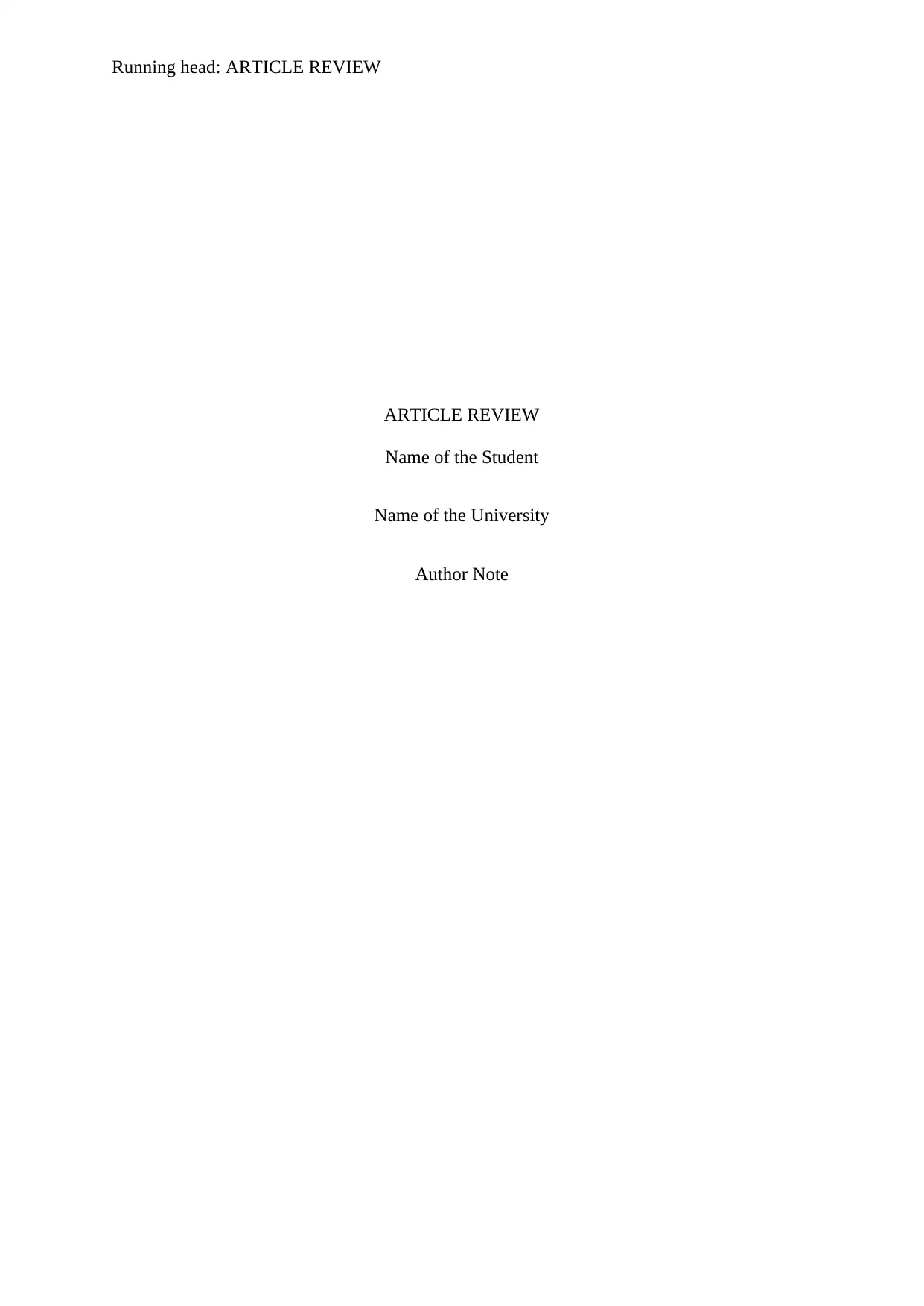
Running head: ARTICLE REVIEW
ARTICLE REVIEW
Name of the Student
Name of the University
Author Note
ARTICLE REVIEW
Name of the Student
Name of the University
Author Note
Secure Best Marks with AI Grader
Need help grading? Try our AI Grader for instant feedback on your assignments.
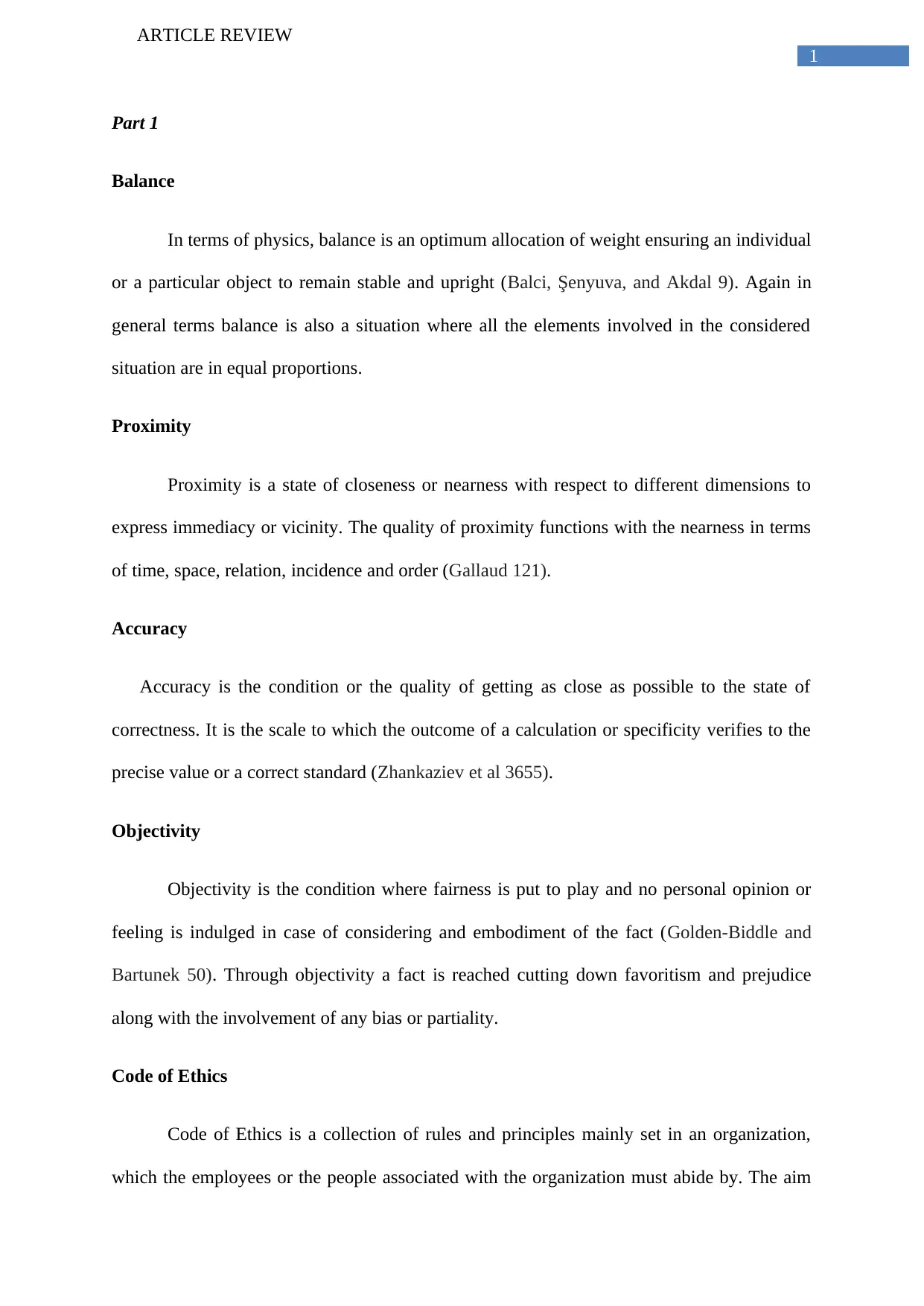
1
ARTICLE REVIEW
Part 1
Balance
In terms of physics, balance is an optimum allocation of weight ensuring an individual
or a particular object to remain stable and upright (Balci, Şenyuva, and Akdal 9). Again in
general terms balance is also a situation where all the elements involved in the considered
situation are in equal proportions.
Proximity
Proximity is a state of closeness or nearness with respect to different dimensions to
express immediacy or vicinity. The quality of proximity functions with the nearness in terms
of time, space, relation, incidence and order (Gallaud 121).
Accuracy
Accuracy is the condition or the quality of getting as close as possible to the state of
correctness. It is the scale to which the outcome of a calculation or specificity verifies to the
precise value or a correct standard (Zhankaziev et al 3655).
Objectivity
Objectivity is the condition where fairness is put to play and no personal opinion or
feeling is indulged in case of considering and embodiment of the fact (Golden-Biddle and
Bartunek 50). Through objectivity a fact is reached cutting down favoritism and prejudice
along with the involvement of any bias or partiality.
Code of Ethics
Code of Ethics is a collection of rules and principles mainly set in an organization,
which the employees or the people associated with the organization must abide by. The aim
ARTICLE REVIEW
Part 1
Balance
In terms of physics, balance is an optimum allocation of weight ensuring an individual
or a particular object to remain stable and upright (Balci, Şenyuva, and Akdal 9). Again in
general terms balance is also a situation where all the elements involved in the considered
situation are in equal proportions.
Proximity
Proximity is a state of closeness or nearness with respect to different dimensions to
express immediacy or vicinity. The quality of proximity functions with the nearness in terms
of time, space, relation, incidence and order (Gallaud 121).
Accuracy
Accuracy is the condition or the quality of getting as close as possible to the state of
correctness. It is the scale to which the outcome of a calculation or specificity verifies to the
precise value or a correct standard (Zhankaziev et al 3655).
Objectivity
Objectivity is the condition where fairness is put to play and no personal opinion or
feeling is indulged in case of considering and embodiment of the fact (Golden-Biddle and
Bartunek 50). Through objectivity a fact is reached cutting down favoritism and prejudice
along with the involvement of any bias or partiality.
Code of Ethics
Code of Ethics is a collection of rules and principles mainly set in an organization,
which the employees or the people associated with the organization must abide by. The aim
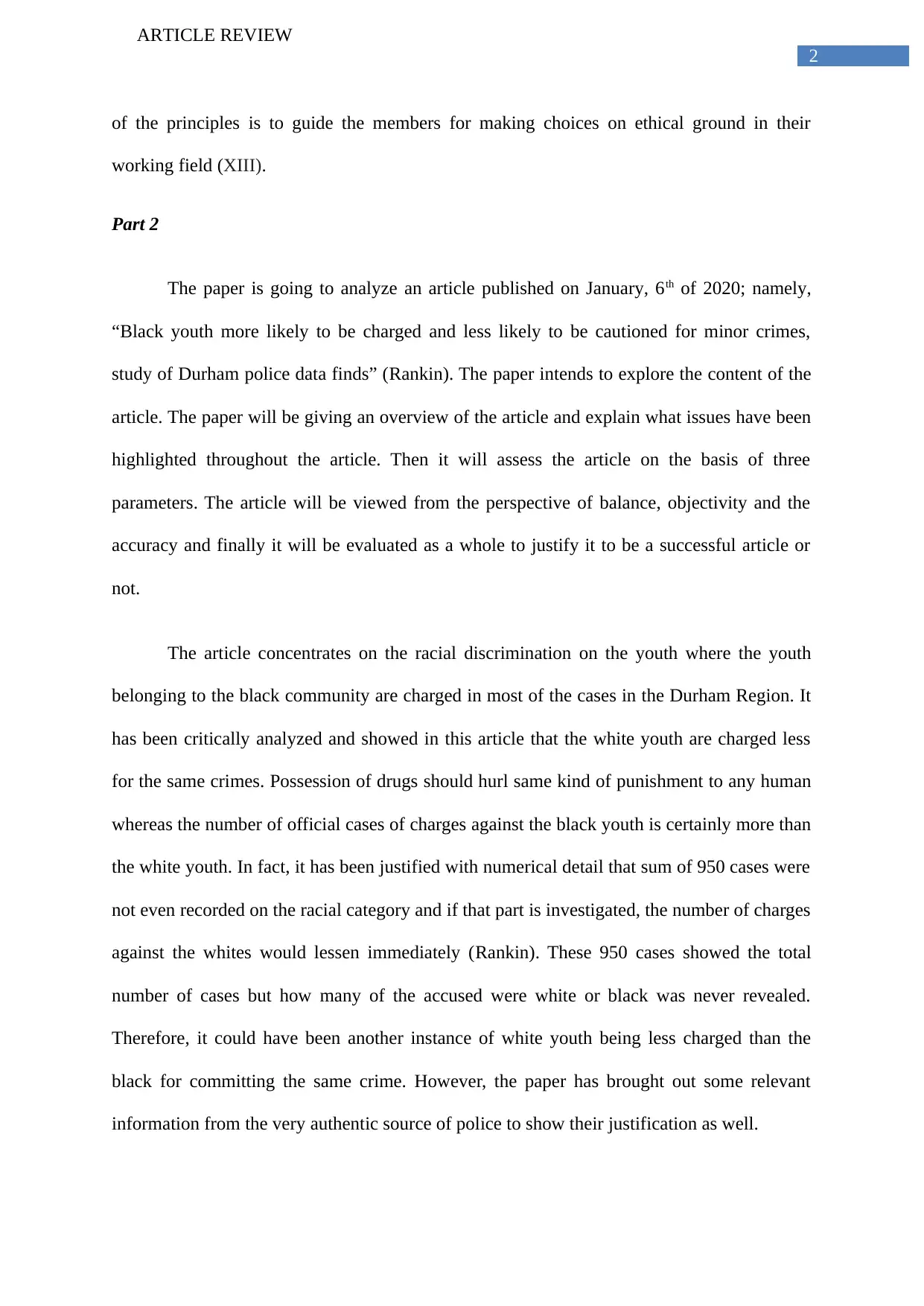
2
ARTICLE REVIEW
of the principles is to guide the members for making choices on ethical ground in their
working field (XIII).
Part 2
The paper is going to analyze an article published on January, 6th of 2020; namely,
“Black youth more likely to be charged and less likely to be cautioned for minor crimes,
study of Durham police data finds” (Rankin). The paper intends to explore the content of the
article. The paper will be giving an overview of the article and explain what issues have been
highlighted throughout the article. Then it will assess the article on the basis of three
parameters. The article will be viewed from the perspective of balance, objectivity and the
accuracy and finally it will be evaluated as a whole to justify it to be a successful article or
not.
The article concentrates on the racial discrimination on the youth where the youth
belonging to the black community are charged in most of the cases in the Durham Region. It
has been critically analyzed and showed in this article that the white youth are charged less
for the same crimes. Possession of drugs should hurl same kind of punishment to any human
whereas the number of official cases of charges against the black youth is certainly more than
the white youth. In fact, it has been justified with numerical detail that sum of 950 cases were
not even recorded on the racial category and if that part is investigated, the number of charges
against the whites would lessen immediately (Rankin). These 950 cases showed the total
number of cases but how many of the accused were white or black was never revealed.
Therefore, it could have been another instance of white youth being less charged than the
black for committing the same crime. However, the paper has brought out some relevant
information from the very authentic source of police to show their justification as well.
ARTICLE REVIEW
of the principles is to guide the members for making choices on ethical ground in their
working field (XIII).
Part 2
The paper is going to analyze an article published on January, 6th of 2020; namely,
“Black youth more likely to be charged and less likely to be cautioned for minor crimes,
study of Durham police data finds” (Rankin). The paper intends to explore the content of the
article. The paper will be giving an overview of the article and explain what issues have been
highlighted throughout the article. Then it will assess the article on the basis of three
parameters. The article will be viewed from the perspective of balance, objectivity and the
accuracy and finally it will be evaluated as a whole to justify it to be a successful article or
not.
The article concentrates on the racial discrimination on the youth where the youth
belonging to the black community are charged in most of the cases in the Durham Region. It
has been critically analyzed and showed in this article that the white youth are charged less
for the same crimes. Possession of drugs should hurl same kind of punishment to any human
whereas the number of official cases of charges against the black youth is certainly more than
the white youth. In fact, it has been justified with numerical detail that sum of 950 cases were
not even recorded on the racial category and if that part is investigated, the number of charges
against the whites would lessen immediately (Rankin). These 950 cases showed the total
number of cases but how many of the accused were white or black was never revealed.
Therefore, it could have been another instance of white youth being less charged than the
black for committing the same crime. However, the paper has brought out some relevant
information from the very authentic source of police to show their justification as well.
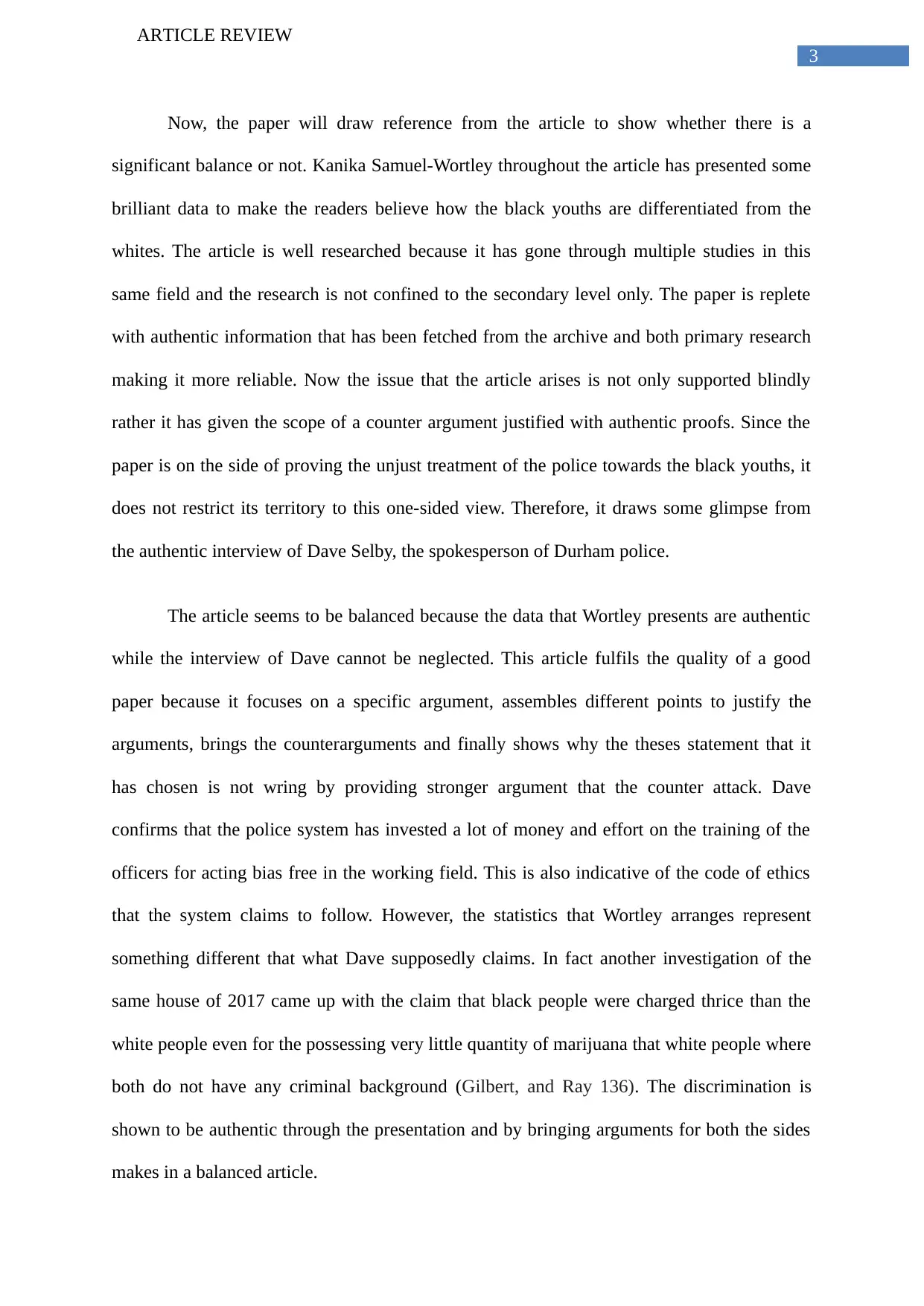
3
ARTICLE REVIEW
Now, the paper will draw reference from the article to show whether there is a
significant balance or not. Kanika Samuel-Wortley throughout the article has presented some
brilliant data to make the readers believe how the black youths are differentiated from the
whites. The article is well researched because it has gone through multiple studies in this
same field and the research is not confined to the secondary level only. The paper is replete
with authentic information that has been fetched from the archive and both primary research
making it more reliable. Now the issue that the article arises is not only supported blindly
rather it has given the scope of a counter argument justified with authentic proofs. Since the
paper is on the side of proving the unjust treatment of the police towards the black youths, it
does not restrict its territory to this one-sided view. Therefore, it draws some glimpse from
the authentic interview of Dave Selby, the spokesperson of Durham police.
The article seems to be balanced because the data that Wortley presents are authentic
while the interview of Dave cannot be neglected. This article fulfils the quality of a good
paper because it focuses on a specific argument, assembles different points to justify the
arguments, brings the counterarguments and finally shows why the theses statement that it
has chosen is not wring by providing stronger argument that the counter attack. Dave
confirms that the police system has invested a lot of money and effort on the training of the
officers for acting bias free in the working field. This is also indicative of the code of ethics
that the system claims to follow. However, the statistics that Wortley arranges represent
something different that what Dave supposedly claims. In fact another investigation of the
same house of 2017 came up with the claim that black people were charged thrice than the
white people even for the possessing very little quantity of marijuana that white people where
both do not have any criminal background (Gilbert, and Ray 136). The discrimination is
shown to be authentic through the presentation and by bringing arguments for both the sides
makes in a balanced article.
ARTICLE REVIEW
Now, the paper will draw reference from the article to show whether there is a
significant balance or not. Kanika Samuel-Wortley throughout the article has presented some
brilliant data to make the readers believe how the black youths are differentiated from the
whites. The article is well researched because it has gone through multiple studies in this
same field and the research is not confined to the secondary level only. The paper is replete
with authentic information that has been fetched from the archive and both primary research
making it more reliable. Now the issue that the article arises is not only supported blindly
rather it has given the scope of a counter argument justified with authentic proofs. Since the
paper is on the side of proving the unjust treatment of the police towards the black youths, it
does not restrict its territory to this one-sided view. Therefore, it draws some glimpse from
the authentic interview of Dave Selby, the spokesperson of Durham police.
The article seems to be balanced because the data that Wortley presents are authentic
while the interview of Dave cannot be neglected. This article fulfils the quality of a good
paper because it focuses on a specific argument, assembles different points to justify the
arguments, brings the counterarguments and finally shows why the theses statement that it
has chosen is not wring by providing stronger argument that the counter attack. Dave
confirms that the police system has invested a lot of money and effort on the training of the
officers for acting bias free in the working field. This is also indicative of the code of ethics
that the system claims to follow. However, the statistics that Wortley arranges represent
something different that what Dave supposedly claims. In fact another investigation of the
same house of 2017 came up with the claim that black people were charged thrice than the
white people even for the possessing very little quantity of marijuana that white people where
both do not have any criminal background (Gilbert, and Ray 136). The discrimination is
shown to be authentic through the presentation and by bringing arguments for both the sides
makes in a balanced article.
Paraphrase This Document
Need a fresh take? Get an instant paraphrase of this document with our AI Paraphraser

4
ARTICLE REVIEW
The article must be examined on the second parameter and that is the objectivity. The
thesis statement shows what the article is about to present. It is clear from the definition of
objectivity that fact is presented without any form of bias and involvement of personal
feelings. This paper has nothing to do with bias. When Dave is interviewed for representing
the police force, he also talks about the policy vehemently without hiding any detail. He
claims that the service they are assigned to offer should be fair and equal however, there are
people who might not be entirely free from bias that is why the force is enabling some
training for years to make it a practice (Bonner and Stacey 84). Wortley, without showing any
bias presents the data. No emotional interferences or infusion of emotional interpretation
have been the topic of the article. It claims to work with a serious issue and the article
justifiably does so. It goes through finding some real information related to the cases and
presents them in form of raw materials to derive the fact. Hence, it is clear that the article is
clearly fair and has no point of entreating any bias or prejudice. Although the argument itself
sounds very prejudiced yet the article skillfully derives all the information from various kinds
of study to prove its objectivity to be complete free from prejudice.
The next sphere on which the article will be assessed is the accuracy or the
correctness. By accuracy it is meant that whether the information that have been put inside
the article to justify the arguments are relevant and correct or not. The article, as already
mentioned provides the readers with some data starting from the journal of “Race ad Justice”,
which consists the study on the cases that have been taking places from 2007. The percentage
those are mentioned in the paper throughout have been used from a reliable source of studies
of several years of Samuel-Wortley who had been a promising candidate of PhD at Waterloo
University. In order to prove the accuracy, it can be said that the article has discussed in detail
with what the police representative had to say about the argument. Not only that his words
from the interview have been quoted in to article to show its accuracy and keep the paper
ARTICLE REVIEW
The article must be examined on the second parameter and that is the objectivity. The
thesis statement shows what the article is about to present. It is clear from the definition of
objectivity that fact is presented without any form of bias and involvement of personal
feelings. This paper has nothing to do with bias. When Dave is interviewed for representing
the police force, he also talks about the policy vehemently without hiding any detail. He
claims that the service they are assigned to offer should be fair and equal however, there are
people who might not be entirely free from bias that is why the force is enabling some
training for years to make it a practice (Bonner and Stacey 84). Wortley, without showing any
bias presents the data. No emotional interferences or infusion of emotional interpretation
have been the topic of the article. It claims to work with a serious issue and the article
justifiably does so. It goes through finding some real information related to the cases and
presents them in form of raw materials to derive the fact. Hence, it is clear that the article is
clearly fair and has no point of entreating any bias or prejudice. Although the argument itself
sounds very prejudiced yet the article skillfully derives all the information from various kinds
of study to prove its objectivity to be complete free from prejudice.
The next sphere on which the article will be assessed is the accuracy or the
correctness. By accuracy it is meant that whether the information that have been put inside
the article to justify the arguments are relevant and correct or not. The article, as already
mentioned provides the readers with some data starting from the journal of “Race ad Justice”,
which consists the study on the cases that have been taking places from 2007. The percentage
those are mentioned in the paper throughout have been used from a reliable source of studies
of several years of Samuel-Wortley who had been a promising candidate of PhD at Waterloo
University. In order to prove the accuracy, it can be said that the article has discussed in detail
with what the police representative had to say about the argument. Not only that his words
from the interview have been quoted in to article to show its accuracy and keep the paper
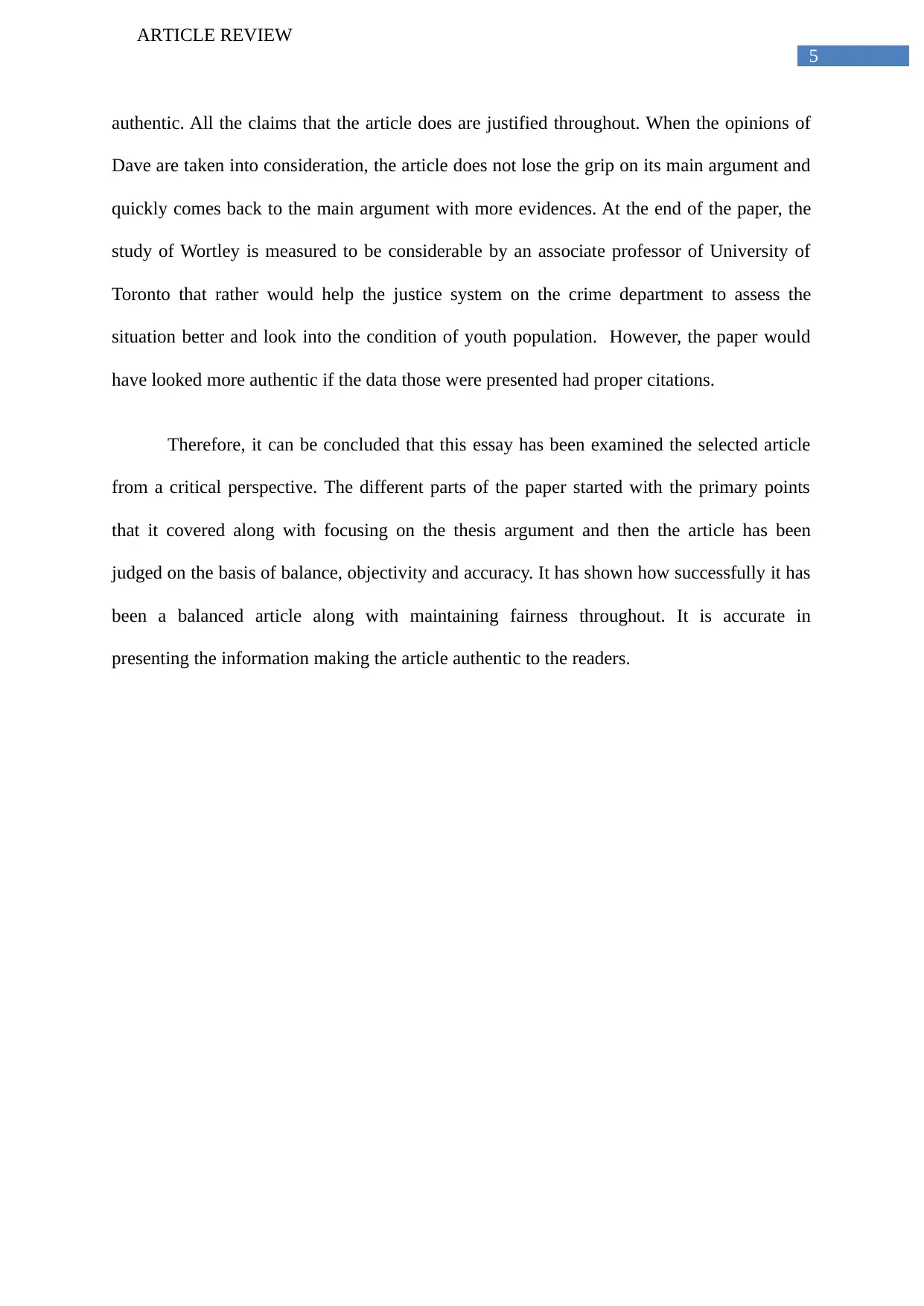
5
ARTICLE REVIEW
authentic. All the claims that the article does are justified throughout. When the opinions of
Dave are taken into consideration, the article does not lose the grip on its main argument and
quickly comes back to the main argument with more evidences. At the end of the paper, the
study of Wortley is measured to be considerable by an associate professor of University of
Toronto that rather would help the justice system on the crime department to assess the
situation better and look into the condition of youth population. However, the paper would
have looked more authentic if the data those were presented had proper citations.
Therefore, it can be concluded that this essay has been examined the selected article
from a critical perspective. The different parts of the paper started with the primary points
that it covered along with focusing on the thesis argument and then the article has been
judged on the basis of balance, objectivity and accuracy. It has shown how successfully it has
been a balanced article along with maintaining fairness throughout. It is accurate in
presenting the information making the article authentic to the readers.
ARTICLE REVIEW
authentic. All the claims that the article does are justified throughout. When the opinions of
Dave are taken into consideration, the article does not lose the grip on its main argument and
quickly comes back to the main argument with more evidences. At the end of the paper, the
study of Wortley is measured to be considerable by an associate professor of University of
Toronto that rather would help the justice system on the crime department to assess the
situation better and look into the condition of youth population. However, the paper would
have looked more authentic if the data those were presented had proper citations.
Therefore, it can be concluded that this essay has been examined the selected article
from a critical perspective. The different parts of the paper started with the primary points
that it covered along with focusing on the thesis argument and then the article has been
judged on the basis of balance, objectivity and accuracy. It has shown how successfully it has
been a balanced article along with maintaining fairness throughout. It is accurate in
presenting the information making the article authentic to the readers.
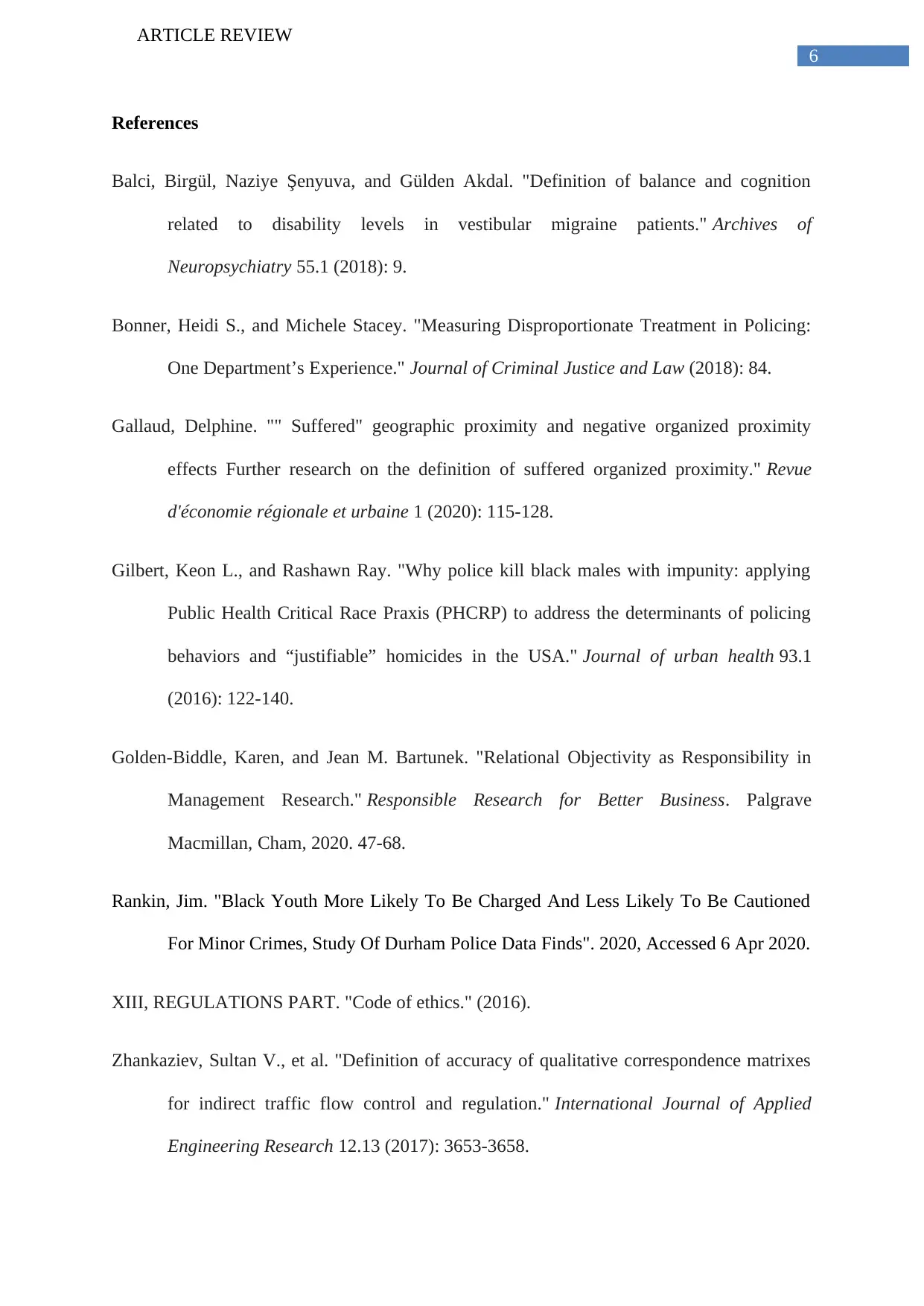
6
ARTICLE REVIEW
References
Balci, Birgül, Naziye Şenyuva, and Gülden Akdal. "Definition of balance and cognition
related to disability levels in vestibular migraine patients." Archives of
Neuropsychiatry 55.1 (2018): 9.
Bonner, Heidi S., and Michele Stacey. "Measuring Disproportionate Treatment in Policing:
One Department’s Experience." Journal of Criminal Justice and Law (2018): 84.
Gallaud, Delphine. "" Suffered" geographic proximity and negative organized proximity
effects Further research on the definition of suffered organized proximity." Revue
d'économie régionale et urbaine 1 (2020): 115-128.
Gilbert, Keon L., and Rashawn Ray. "Why police kill black males with impunity: applying
Public Health Critical Race Praxis (PHCRP) to address the determinants of policing
behaviors and “justifiable” homicides in the USA." Journal of urban health 93.1
(2016): 122-140.
Golden-Biddle, Karen, and Jean M. Bartunek. "Relational Objectivity as Responsibility in
Management Research." Responsible Research for Better Business. Palgrave
Macmillan, Cham, 2020. 47-68.
Rankin, Jim. "Black Youth More Likely To Be Charged And Less Likely To Be Cautioned
For Minor Crimes, Study Of Durham Police Data Finds". 2020, Accessed 6 Apr 2020.
XIII, REGULATIONS PART. "Code of ethics." (2016).
Zhankaziev, Sultan V., et al. "Definition of accuracy of qualitative correspondence matrixes
for indirect traffic flow control and regulation." International Journal of Applied
Engineering Research 12.13 (2017): 3653-3658.
ARTICLE REVIEW
References
Balci, Birgül, Naziye Şenyuva, and Gülden Akdal. "Definition of balance and cognition
related to disability levels in vestibular migraine patients." Archives of
Neuropsychiatry 55.1 (2018): 9.
Bonner, Heidi S., and Michele Stacey. "Measuring Disproportionate Treatment in Policing:
One Department’s Experience." Journal of Criminal Justice and Law (2018): 84.
Gallaud, Delphine. "" Suffered" geographic proximity and negative organized proximity
effects Further research on the definition of suffered organized proximity." Revue
d'économie régionale et urbaine 1 (2020): 115-128.
Gilbert, Keon L., and Rashawn Ray. "Why police kill black males with impunity: applying
Public Health Critical Race Praxis (PHCRP) to address the determinants of policing
behaviors and “justifiable” homicides in the USA." Journal of urban health 93.1
(2016): 122-140.
Golden-Biddle, Karen, and Jean M. Bartunek. "Relational Objectivity as Responsibility in
Management Research." Responsible Research for Better Business. Palgrave
Macmillan, Cham, 2020. 47-68.
Rankin, Jim. "Black Youth More Likely To Be Charged And Less Likely To Be Cautioned
For Minor Crimes, Study Of Durham Police Data Finds". 2020, Accessed 6 Apr 2020.
XIII, REGULATIONS PART. "Code of ethics." (2016).
Zhankaziev, Sultan V., et al. "Definition of accuracy of qualitative correspondence matrixes
for indirect traffic flow control and regulation." International Journal of Applied
Engineering Research 12.13 (2017): 3653-3658.
1 out of 7
![[object Object]](/_next/static/media/star-bottom.7253800d.svg)